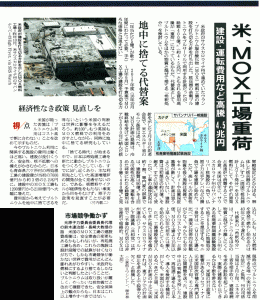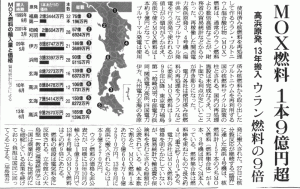Original Japanese written by staffer
The English below written and arranged by Heeday, based on the original Japanese
The English edited by Rev. Dr. Henry French, ELCA
Article from the February 28th, 2016 edition of the Asahi Shimbun newspaper
▼Click the image to read an English summary of the Japanese article.
The power companies do not disclose the cost of “uranium oxide fuel” (as distinct from mixed oxides [MOX]) either, yet the same calculation described above obtains an average uranium fuel cost of JPY 118.73 million in July, 1998. The average price slightly diminished to JPY 102.59 million in October, 2013. The MOX imported in June of the same year carried a price tag almost 9 times larger.
MOX as a luxury
Japan’s Ministry of Finance’s trade statistics and some other sources have shown that a mixed oxide (MOX) fuel of plutonium and uranium, made by reprocessing used uranium fuel, is almost nine times pricier than a uranium-only fuel. Kansai Electric Power recently restarted Units 3 and 4 of its Takahama Nuclear Power Plant (located in Fukui, Japan, some 45 miles NNW of Kyoto), using MOX fuel. Takahama’s MOX fuel cost some JPY 900 million apiece.
Makes no economic sense
Japan’s government is insistent on its nuclear fuel cycle policy, which reuses plutonium extracted from used uranium fuel. One major reason for this is to stop the buildup of plutonium generated in reactors. Japan possesses some 47.8 ton (105,381 lb.) of plutonium, which can be used to build nuclear weapons. The nation’s nuclear fuel reprocessing facilities are underdeveloped, however, and now it has become evident that nuclear fuel recycling makes no economic sense.
Broken scheme
No single MOX fuel consumes much plutonium, therefore, MOX production is not an efficient way to consume our abhorrent stock of plutonium. Also, pricey fuels certainly increase the power bills we pay. Prof. Ken’ichi Oshima of Ritsumeikan University, an expert in ecological economics, points out, “Recycling should bring down the cost. The plain fact with MOX fuels is just the opposite. They are a luxury and make no economic sense. In short, the Japanese government is insistent on a policy that is bankrupt both economically and technically. And the people will eventually have to pay for it.”
Doomed fuels
Originally, MOX fuel was meant for use in a fast breeder reactor (FBR). Yet the prototype FBR, Monju (also located in Fukui Pref.) has never run successfully long enough to make sense. Thus, the national government has switched to using MOX fuels in thermal (common) light water reactors. Japan’s major power companies estimate that using MOX fuels at 16 to 18 NPP reactors should consume some 6 tons (13,228 lb.) of plutonium each year. Still, the used nuclear fuel reprocessing plant and MOX fuel processing plant, located in Rokkasho, Aomori Pref. (some 406 miles NNE of Tokyo) are way behind schedule and have yet to operate. To aggravate the issue, the fuel processing plant is incapable of processing used MOX fuel. Thus, no one knows what to do with such used fuel.
Recycling plutonium – and wasting money
The Japan Atomic Energy Commission of Japan’s Cabinet Office, in 2012, announced an estimated cost for the nation’s nuclear fuel recycling. It admitted that the “once through” system, which buries used nuclear fuels without reprocessing them, costs less money than does recycling used fuel’s plutonium, regardless of the ratio of nuclear power in the future power source portfolio.
Article from the March 3rd, 2016 edition of the Asahi Shimbun newspaper
▼Click the image to read an English summary of the Japanese article.

The origin of Japan’s MOX planning dates back to 2000, when the US and Russia signed a nuclear arms reduction agreement in response to the end of the Cold War. The two nations dismantled many nuclear weapons, whose plutonium was to be made into MOX fuel for consumption in light water and fast breeder reactors. Though the US began building a reprocessing plant in 2007, the MOX plan has been on the rocks. An alternative, “watering down to dispose,” mixes plutonium with some other substances to inhibit the extraction of plutonium, and then buries the waste in New Mexico’s nuclear waste disposal facility, some 656m (728 yards) below the ground. US Secretary of Energy, Moniz, endorses this burial plan, saying, “It’s not too late to choose this alternative. Beginning now, we can do this with less than half of the cost necessary with the MOX plant plan. And this burial certainly requires less technical challenges.” Transportation of the plutonium mix can begin in the early 2020s, 15 years before the MOX plant will be ready, according to the Secretary.
Burial in the US
The US government has decided to give up on the building of the MOX fuel plant, which had been underway in South Carolina. Though the plan originally meant to use plutonium collected from discarded nuclear weapons in power generation, the plan costs some USD 40 billion, which is a terrible economic burden. As an alternative, the government is now considering a “water down and bury” disposal plan, which first mixes plutonium with some other substances and then buries the mixture.
And in the UK too?
The tough issues the US experienced shows that plutonium is too expensive for any commercial use. The US government’s decision to bury plutonium underground for cost savings should affect the rest of the world. The UK, which possesses some 100 tons (220,462 lb.) of plutonium, is actually considering such burial as well, though it claims to be using the plutonium in MOX fuels.
Hanging on to the dead —
Thus, the world stands at the threshold of an “age of burying plutonium.” Japan, running against the trend, is trying to build a reprocessing plant to use plutonium. The nation already has almost 50 tons (110,231 lb.) of the deadly element, while its FBR (fast breeder reactor) dream has already proven to be nothing but a fancy. What we really need to do now is to look straight at the fact that the planned nuclear fuel recycling makes no economic sense, and then reconsider the nation’s nuclear power policy.
Nowhere to pull out to?
One reason why Japan cannot pull out of the proposed nuclear fuel recycling is, once the recycling is given up, no NPP in the nation can work. Under the recycling plan, the used fuel, currently kept in water pools within NPPs, is treated as a “resource.” If recycling is abandoned, such fuel simply turns into “garbage.” Unless some new places for the disposal of used fuel are found, the water pools within NPPs would soon be full of such garbage. This disposal problem makes the government hold on to the fancy of “recycling all used nuclear fuel.”
Still, the plain fact, proven worldwide, is that such recycling is simply not feasible. Every citizen should be concerned with energy issues. The nation must find the right way to deal with existing nuclear fuel and reduce the risks and burdens accompanying such fuel.

